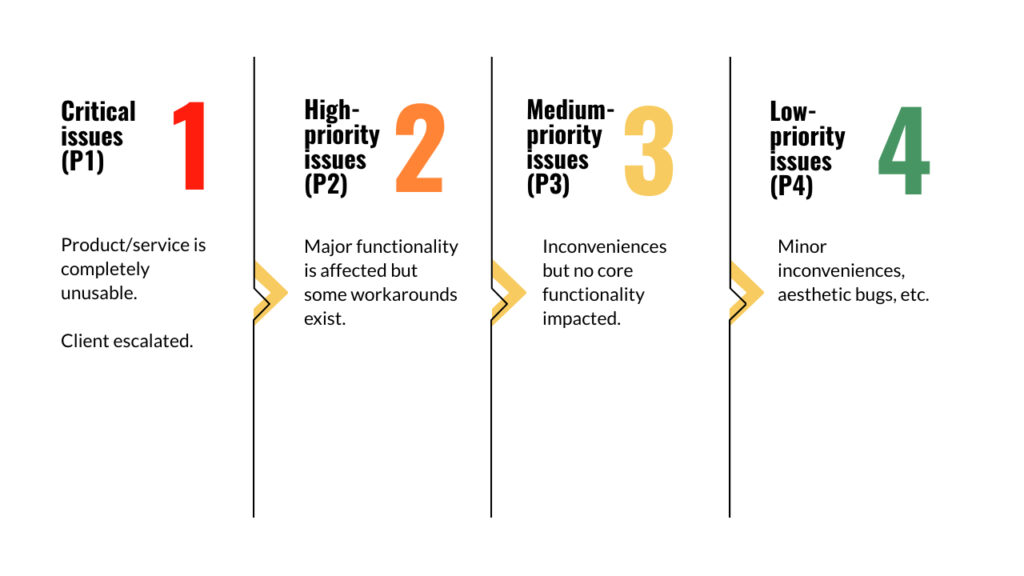How to Resolve High-Impact Issues First, Improve Response Times, and Increase Customer Satisfaction for Fast-Growing SMBs
Customer support has evolved from just resolving issues to crafting experiences that elevate satisfaction and keeping customers happy and engaged.
For fast-growing SMBs, scaling customer support operations can be challenging, especially when it comes to prioritizing high-impact issues and improving response times without sacrificing quality.
This guide will walk you through key strategies for resolving critical support issues quickly, enhancing response times, and boosting customer satisfaction, so your business can maintain growth without compromising the customer experience.
Let’s break it down.
1. Prioritize High-Impact Issues: It’s About Value, Not Volume
At any given time, your support team is juggling countless tickets. The mistake many growing SMBs make is addressing issues in the order they come in, rather than by their potential impact. While that might seem fair, it doesn’t align with delivering real value to your customers.
Instead, focus on high-impact issues first. These are the problems that:
- Affect a large number of users
- Directly hinder product functionality
- Pose a risk to customer retention or satisfaction
Here’s a quick framework for prioritization:

- Critical issues (P1): Product/service is completely unusable.
- High-priority issues (P2): Major functionality is affected but some workarounds exist.
- Medium-priority issues (P3): Inconveniences but no core functionality impacted.
- Low-priority issues (P4): Minor inconveniences, aesthetic bugs, etc.
By assigning each ticket a priority level based on these categories, your team can focus on issues that truly matter, rather than playing catch-up with the ticket queue.
2. Streamline Response Times With Automation—Without Losing the Human Touch
Automation is an amazing tool for handling repetitive tasks (like assigning tickets, sending follow-up reminders, or answering common FAQs), but the key is not over-automating. Too much automation, and you risk losing the personal touch that customers value in support interactions.
Here’s where the balance lies:
- Automate ticket routing. Ensure high-priority tickets are escalated immediately, and low-impact ones are routed to self-service or tier-1 support.
- Set up automated follow-ups. If a ticket has been sitting without an update for a while, use automation to send a polite reminder to the customer that you’re still working on it.
- Leverage AI chatbots for Tier-1 support. Allow bots to handle basic queries like “How do I reset my password?” so human agents can focus on complex issues.
But remember, always provide customers with an easy path to escalate to a human. It’s frustrating to be stuck in a chatbot loop when you need real assistance.
3. Implement Self-Service for the 80% Rule
For fast-growing SMBs, the 80/20 rule is gold: 80% of your support inquiries come from 20% of the same questions. So why not let customers solve these common problems on their own?
By creating a robust knowledge base or help center, you can empower customers to find solutions on their own terms, without waiting for an agent. This not only improves customer satisfaction (because people like solving things on their own!) but also frees up your team to deal with the more high-impact issues.
Best practices for self-service include:
- A searchable, well-organized knowledge base.
- Step-by-step tutorials or video guides.
- Community forums where users can ask and answer questions.
4. Foster Customer Feedback Loops
You can’t fix what you don’t know is broken, which is why continuous feedback is essential. Fast-growing companies often overlook gathering consistent customer insights, but feedback loops allow you to stay agile, respond to new pain points, and adjust quickly.
- Send automated CSAT surveys after every interaction to measure customer satisfaction.
- Implement NPS (Net Promoter Score) to see if customers would recommend your product.
- Hold quarterly CES (Customer Effort Score) surveys to gauge how easy it is for customers to resolve issues.
The goal is to act on this feedback quickly. If your NPS or CSAT scores are dropping, dig into the root cause, tweak your processes, and communicate the changes to your customers. Transparency builds trust, and your customers will appreciate the effort.
5. Monitor and Optimize Your Team’s Performance in Real-Time
Managing a fast-growing customer support team is challenging. To ensure your team performs at its best, use real-time performance analytics. This will allow you to keep track of:
- Response times: How long does it take for an agent to respond to a customer?
- Resolution rates: How many issues are resolved within the first interaction?
- Customer satisfaction: What are your CSAT scores for each agent or interaction?
Tools like Zendesk or Freshdesk can provide these insights, helping you make data-driven decisions. By keeping a close eye on your team’s performance, you can coach underperforming agents and highlight your rockstars.
6. Anticipate Customer Needs Before They Arise
Being proactive instead of reactive is a game-changer for SMBs. Proactively reaching out to customers before they encounter issues shows that you care about their success. Here are a few ways to do this:
- Send onboarding emails that educate new users on how to avoid common issues.
- Create “health check” reports for your customers, showing them how they’re using your product and where they might face challenges in the future.
- Personalized outreach during renewal periods to identify potential issues early on.
Wrapping Up: Simplifying Support for Scalable Growth
As SMBs grow, maintaining quality support is all about prioritization, streamlining processes, and continuously improving. By focusing on high-impact issues, automating the right areas, and putting a strong feedback loop in place, your support team can keep customers happy while your company grows.
If you’re looking to build a world-class customer support team that can help you achieve these goals without the headache of hiring, training, and managing an internal team, Techsho can help. We specialize in setting up cost-effective, high-performing support teams in APAC and LatAm, saving you time and money while delivering exceptional customer service.
Need help scaling your support operations? Let’s chat!


